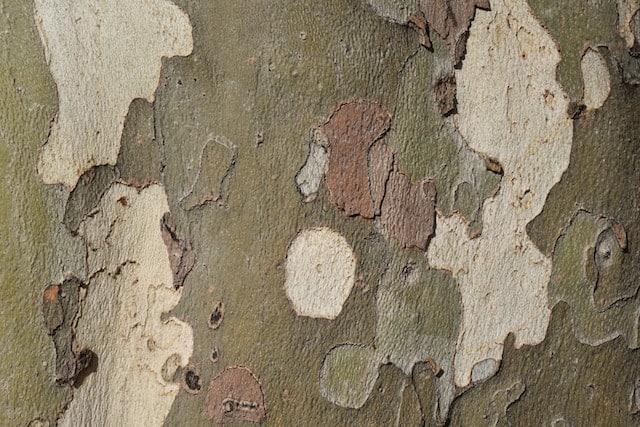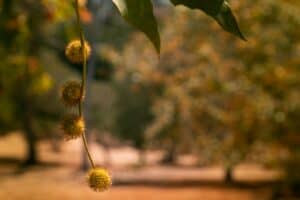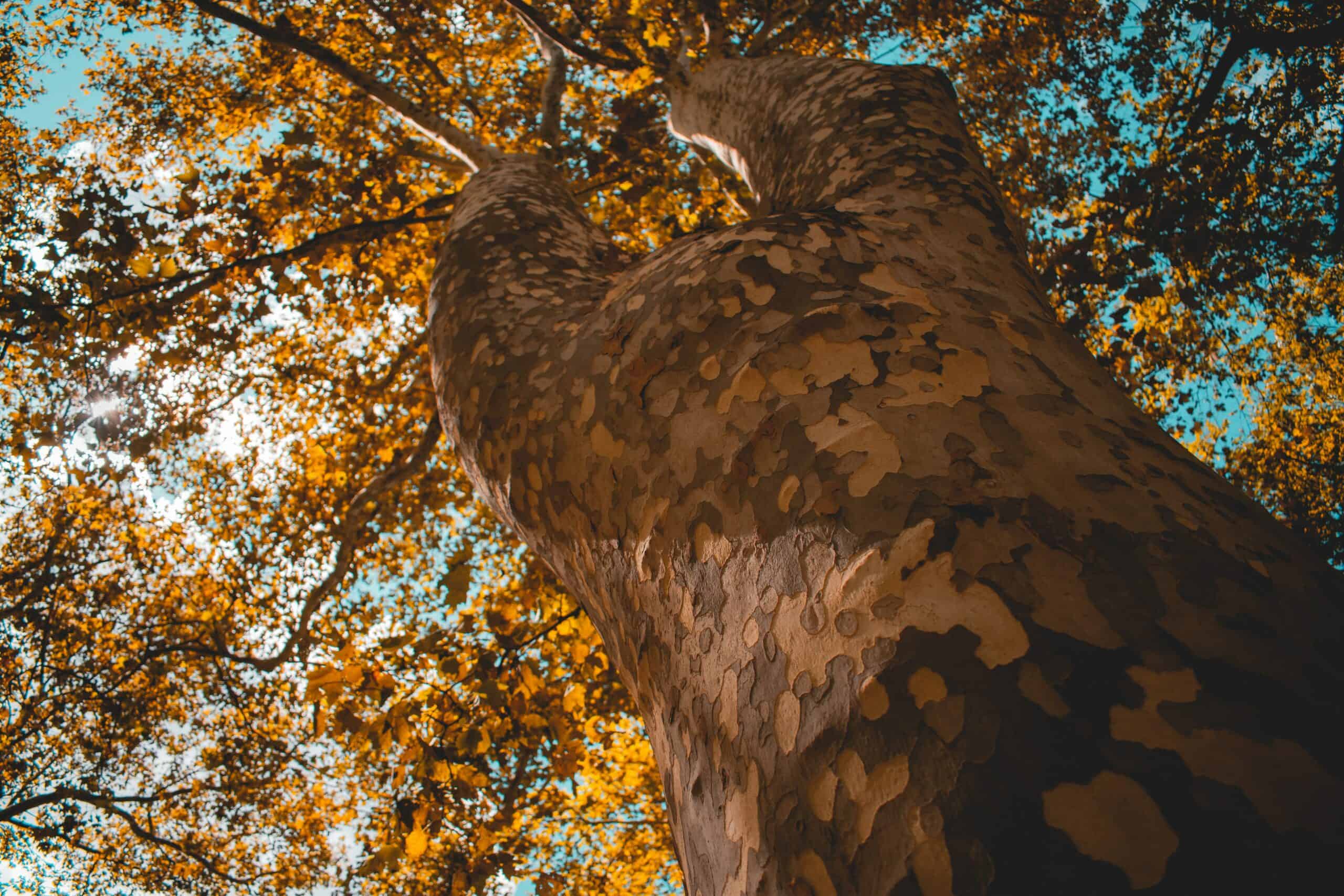The sycamore tree is a shade tree. They can grow 70 – 100 feet and sometimes higher. Sycamores need lots of space to grow. You’ll often see them in parks and lining streets. They are fast-growing trees, growing over two feet per year. With a deep root system, they are very sturdy.
Sycamore trees are deciduous and provide shade with their large canopies. Because of their size and aggressive roots, they grow well in areas with a lot of space. Sycamore leaves resemble maple leaves. You can recognize sycamores for their round seed balls and exfoliating bark which gives a mottled appearance.
Here’s what to know about the sycamore tree, including what it looks like, different types, uses, how tall it grows, what it takes to grow sycamores, and more.
Sycamore Tree
The sycamore (Platanus species) is a deciduous tree, often planted for shade. There are 10 species. Scaling 70 – 100 feet tall, this tree isn’t one you see often in neighborhoods. Mature sycamore tree trunks can be 4 -10+ feet in diameter.
In addition to providing shade, its wood is durable enough to make several products. Its button balls can also be used in creating craft items such as decorations.
How Do You Identify a Sycamore Tree?
To identify a sycamore tree, look for a jigsaw pattern to the bark. There are many features which make it stand out. They grow with a straight trunk and horizontal branching. The common features to look for when trying to identify the tree are:

-
Peeling Bark
Sycamores are fast-growing trees. As it expands and grows, it adds a new sapwood layer. This causes the outer bark to split and crack. As the outer bark layer sheds, sycamore bark flakes off in large, thin, brittle plates. You’ll notice an appearance that is flaky and very patchy. Shedding bark on sycamore trees is normal. Their bark exfoliates as it grows. The mottled bark makes it easy to identify.
-
Camouflage-Like Colors
Sycamore tree bark has camouflage-style colors like green, white, or tan. These colors are indicators of age. An older sycamore tree bark will tend to peel off and reveal a younger sycamore tree bark with different colors. Patterns will vary by tree and age.
-
Dome-Like Canopy
Sycamore trees have a distinct looking canopy shape, often compared to a large dome. This large canopy of big, light green leaves spreads out and creates dense shade, covering the tree. Width can be 75 – 100 feet and greater. Because of this, sycamores are considered to be shade trees. This makes the sycamore tree ideal in parks and campuses.
-
Height
Sycamores are massive trees. Mature height is 70 – 100 feet tall. Some will grow to 150+ feet. Their height makes them suitable for parks, along roads, and in reclamation areas but not always for neighborhoods. They grow naturally in the foothills and in bottomlands, near streams and other water sources.
-
Trunk
A sycamore tree has a wide trunk. Mature trunk width can be as wide as 4 – 14 feet in diameter.
-
Leaves
Sycamore tree leaves resemble maple leaves. They are large and light green to green. The leaves turn brown in the fall. Because of the tree’s large canopy and size, many leaves drop from sycamores.
Sycamores are deciduous and drop their leaves annually. They don’t always drop them in the fall. Many leaves will drop in wind and storms throughout winter. Depending on the conditions they are growing in, they may hold on to their leaves until as late as early spring.

-
Buttonballs
Sycamores grow “button ball” fruit clusters. These are seed balls. The seeds are tightly-packed into large round fruits or balls, which hang near the tips of branchlets. They are around one inch in diameter, dry, hairy, and burr like. They hang in groups of 2 – 7. The fruits drop in the fall. Many people use these for crafts and decoration.
-
Roots
Sycamore tree roots grow down, not toward the surface like many other trees. They have a deep root system. Their roots are aggressive. When planting sycamores, it’s important to be 15 feet away from buildings and structures.
Types of Sycamore Trees
There are 10 species. Below are common types of sycamores.
American Sycamore / American Planetree
Platanus occidentalis, the American sycamore tree, has a coverage area that stretches as far north as southern Ontario in Canada all the way down to parts of eastern Mexico. American sycamore is native in 36 states, including eastern and central United States.
As one of the largest native trees in the USA, they are most prominent throughout southern New England, the Midwest, and much of the deep south. These sycamores grow in USDA hardiness zones 4b – 9a.
American sycamore is also called American planetree and American plane tree. Other names include sycamore, Eastern sycamore, occidental plane, buttonball, and buttonwood. It’s called buttonball because it produces “button ball” fruit clusters.
American planetree grows up 75 – 100 feet tall and can grow as tall as 175 feet. Mature trunks can grow to 10 – 14 feet in diameter.
These are the most common of sycamore trees with their reddish tree bark that peels off, revealing the younger bark’s camo colors. American sycamore leaves have veins which radiate out from a single point. They are palmately veined. Leaves are large with 3 – 5 lobes. The edges are like saw teeth.
American sycamore trees prefer rich, moist and well-draining soils. However, they will grow in almost any type of soil, including soil with low or high pH levels. They tolerate moderate drought. American sycamores thrive in direct sunlight but will grow in moderate shade.
Bacterial leaf scorch can affect this type of sycamore. This is bacterium which causes leaves to curl and turn brown. If left untreated, it can eventually destroy the tree.
Another health concern for American planetrees are sycamore lace bugs. These feed on the underside of leaves during late summer and into autumn.
Mexican Sycamore
Platanus mexicana, the Mexican sycamore tree, is prominent in parts of Texas. They also grow in Florida. They are native to central and northeastern Mexico.
Mature height is typically 50 – 80 feet, generally slightly shorter than American sycamores. Mexican sycamores can grow 36 inches a year. Their canopies span 30 feet.
Mexican sycamore leaves are broad and can grow up to eight inches wide. They are olive green in color. In the fall, some may change to yellow. They have a silvery and cottony white underside. A deciduous tree, they drop their leaves in December. During the winter months, the bark color turns white.
Mexican sycamore is flood tolerant and drought tolerant. In addition, they are hardy to 0 degrees F. They grow in hardiness zones 4 – 9. They prefer full sun but do well in moderate shade.
Like American sycamores, these trees are adaptable. They can grow in sand, loam or clay soils. Whether the soil is wet or dry, they will grow. The Mexican sycamore tree is resistant to Texas root rot and Verticillium. They tolerate highly acidic to highly alkaline soil as well.
Because they are smaller in stature than American planetrees, they may be better suited in neighborhoods. Still, these are large trees; you cannot plant them near homes or near pavement due to their deep and aggressive roots. Also, because of their height, you cannot plant them near power lines.
While American sycamores could be more susceptible to common diseases, such as bacterial leaf scorch, this disease can affect the Mexican sycamore. Another concern can be sycamore lace bugs. But like with bacterial leaf scorch, Mexican sycamores are more resistant than American sycamores are.
Arizona Sycamore
Platanus wrightii, the Arizona sycamore tree, is indigenous to the American southwest, specifically Arizona and New Mexico. It’s also prominent in some parts of Northern Mexico, including Chihuahua, Sonora, and Sinaloa regions.
You will find Arizona sycamores in Arizona, New Mexico and Mexico in areas between 2,000 – 6,000 feet in elevation. This rugged shade tree thrives in riparian washes and canyon bottoms. Oftentimes, you will see them lining trees and in parks to provide shade.
The Arizona sycamore grows up to 80 feet in height. Their canopies span up to 60 feet wide.
The bark is similar to the other sycamores with regard to exfoliating bark in camo shapes. Arizona sycamore bark is smooth and gray-to-green in color when young. Once mature, the bark peels into large jigsaw puzzle-shaped pieces exposing white bark. Because these trees continuously grow, they continue to exfoliate into changing shapes. In the wintertime, you will notice its ornamental mottled bark and white trunk.
A woody deciduous perennial, Arizona sycamores have green leaves and clusters of buttonballs which hold seeds. These are clustered into pendant chains of three or more balls.
Arizona sycamore tree roots are good soil binders. This makes them ideal in areas where you want to prevent excessive erosion.
This type of sycamore grows in sunset zones 10 – 24 and USDA hardiness zones 7 – 11. You can plant Arizona sycamores most anytime of year. These deciduous trees thrive in full sun.
After they are established, they require moderate watering. They do best in well-draining soil but are tolerant to many conditions. They grow in clay, loam, and sandy soils and can tolerate low to high pH levels.
Leaf blight caused by sycamore anthracnose is something that can affect the health of Arizona sycamores.
California Sycamore
Platanus racemosa, the California sycamore has similarities to American sycamores. Other names for it include California plane tree and western sycamore.
California sycamores are native in central and southern California and into Mexico. They grow in plant hardiness zones 7 – 10. Mature height is between 40 – 100 feet with a spread of 40 – 70 feet at maturity. Also considered a fast-growing tree, they grow over two feet per year. Like most sycamores, they are best suited for large-scale landscaping.
California sycamore leaves span 6 – 12″ and are deep green. The leaves have 3 – 5 lobes.
They grow best in a minimum of six hours of direct and unfiltered sunlight each day.
Like most sycamores, they are able to grow in a variety of soil types, including loamy, sandy, and clay soils. The pH levels can vary from alkaline to acidic. They grow best in moist, rich, well-draining soils. Water until established. These trees are somewhat drought-tolerant.
Like all sycamore trees, California sycamores are attractive nesting spots for birds and wildlife.
What Is the Average Sycamore Tree Growth Rate?
The sycamore tree grows over two feet per year on average. Its mature height ranges from 70 to 100 feet. In ideal conditions, it can be as tall as 120+ feet.
Mature canopy domes can reach between 65 and 80 feet in diameter. Because of this covering, it’s an ideal shade tree. You will find them in parks, reclaimed areas, and lining streets. They grow along streams, valleys and foothills.
Sycamore Tree Growing
The American sycamore and Mexican sycamore grow in USDA plant hardiness zones 4 – 9. Arizona sycamores can grow in zones 7 – 11. California sycamore trees grow in zones 7 – 10.
The sycamore tree is exceptionally tolerant of various soil, including alkaline and acidic soils, and growing conditions. In addition, they tolerate wet soil as well as air pollution.
Water them until they are established. They have the potential to grow tall and wide, but the factors mentioned could hinder that. No pruning is necessary. The exception is if there are codominant stems. These are double leaders growing from the same area from the trunk. Choose the stronger one and remove the other.
Sycamores are easy to maintain. The upkeep will come from raking leaves and button balls, should you live in an area that requires you to do so.
Light exposure should be direct sun for six hours a day. They can tolerate light shade as well.
Sycamore Tree Problems
Some sycamore tree varieties can be susceptible to diseases. Watch for any signs such as a change to the leaves.
If you notice the bark on the lower trunk of the tree is falling off or sloughing, this could be a sign of wetwood. This is a condition which is caused from bacteria which produce internal pressure in the tree. It creates a waterish discharge, called slime flux. You will see it oozing out through wounds in the bark.
Other health conditions which cause sloughing bark on lower tree stems are such as foliar symptoms on leaves (such as discoloration) or dead limbs in the upper tree canopy.
Like with all types of sycamore trees, it should have a single trunk. Double leaders are known as codominant stems. This is when more than one main stems emerge from the same location on the main trunk. It’s important to prune a double leader when the sycamore is young.
What Is a Sycamore Tree Good For?
There are plenty of good uses for sycamore trees. Whether they are in the ground or chopped down for the production of various wood products, they serve multiple purposes.
Shade from the Sun
While they typically grow in larger landscapes, sycamores are large enough to provide you with plenty of shade. Wildlife will also benefit from shade. You’ll find sycamores in parks to provide shade.
Habitat for Wildlife
Many cavity-nesting birds nest inside sycamore trees. Bats, owls, ducks, and other wildlife can call it home. Other birds, such as goldfinches and black birds, will create nests within the branches.
Other wildlife feeds off it sycamores. One example is the California sycamore is a food source for western tiger swallowtail butterfly larva.
Furniture and Home Improvement
Sycamore wood is used for many products. It’s solid and very durable. The wood is difficult to split.
People and companies use it for different types of furniture, including bed frames, headboards, dressers, and even countertops in homes. Sycamore wood can also be used for making hardwood floors.
Cutting Boards
Solid and stable, a sycamore wood cutting board is one of the most popular choices among butchers and cooks for cutting meats and other food items. The boards are not as brittle and easy to break apart than cutting boards made of oak or maple. They are also common in kitchens as butcher blocks.
Woodworking
If you love woodworking or even whittling, sycamore wood is a good option for DIY projects and hobbies. It retains a hard-wearing edge that is great in quality, perfect for carved items. It also alleviates any concerns about durability.
What Are the Balls on a Sycamore Tree For?
The balls on a sycamore tree are known as “button balls”. It is for this reason why sycamore trees are also known as button ball trees. The balls contain seeds.
Growing New Trees
These small, spiky brown balls contain sycamore seeds that are used to plant new trees. In areas where sycamore trees are prominent, these button balls will produce in the winter months. You’ll see them on the ground in the spring, setting the stage for planting and growing of new trees in the adjacent area.
However, these button balls are useful for some other purposes, aside from planting new trees.
Crafts
Button balls have been used for traditional holiday ornaments. Crafters can decorate them in many ways as decorations for the tree. Some people use the button balls to make wreaths or garland. In addition, creative types can use them year round in décor for centerpieces and more.
Food for Birds and Wildlife
Many birds and woodland animals will eat the sycamore seeds from button balls. You can also make bird feeders out of the button balls Cover them with peanut butter and roll them in sunflower seeds.
As Compost
Button balls can decompose over a period of time. As a result, you can use it as compost. If you are someone who wants to provide their garden with plenty of nutrients, look no further than button balls as an unlikely but excellent source. You can compost sycamore tree leaves as well.
Other than that, just as with the leaves, some say the button balls on the ground during the spring tend to be a nuisance of some kind. People don’t realize that those button balls can be used in more ways than one rather than lay on the ground.
What is the Lifespan of a Sycamore Tree?
Sycamores can live to be 600 years old. It’s one of the oldest trees in North America.
What is Special About a Sycamore Tree?
If you live in an area where sycamore trees are abundant, you might find yourself growing one in your yard. This deciduous tree needs lots of space to grow with its stately presence and large limbs. There is litter from leaves and button balls.
Growing a sycamore tree is not suited to all areas because of their aggressive roots and overall size. Sycamore trees are common in parks for shade. They are also used for landscaping and in naturalized areas nearby rivers and streams.
To grow sycamore trees, ideally the soil should be well-draining, moist and rich. However, they are hardy and grow in areas with low soil oxygen and high pH. Sycamore trees prefer full sun or moderate shade.
With its majestic size and mottled bark, a sycamore tree stands out. They are tall and have a wide canopy.
The sycamore is a tree that does get its praise and appreciation in so many ways. It’s fast-growing, growing over two feet per year. They are hardy and easy to maintain. They are among the oldest species of trees. It is regarded for shade. Sycamore wood and button balls also have many uses.
See related:
Featured Image Credit: Alex Boyd, Unsplash

